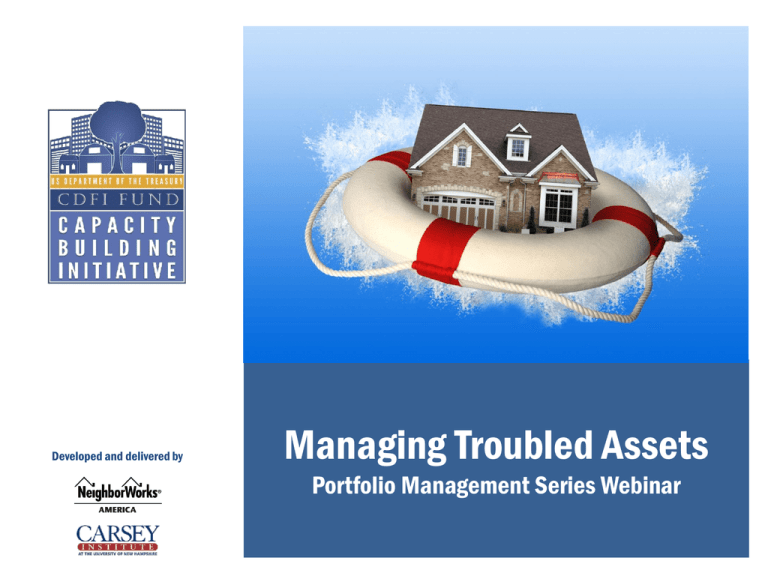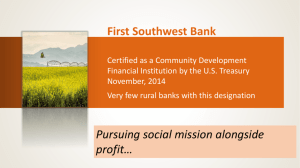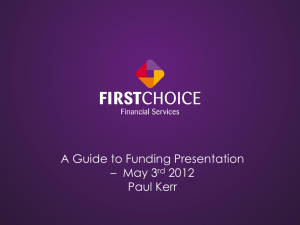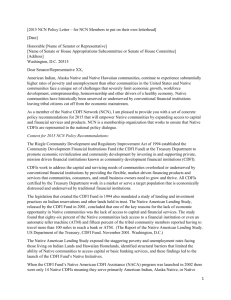Managing Troubled Assets-Portfolio Management Series Webinar
advertisement

Developed and delivered by Managing Troubled Assets Portfolio Management Series Webinar Introductions Ray Waters – President, Enterprise Detroit You, the participants – Small and Large CDFIs – Credit Unions and Banks – Consultants CDFI Fund Capacity Building Initiative Managing Troubled Assets Overarching Themes Jump on problems early – Much easier to bring a loan that is 15 days past due to current than to rescue a loan 120 days past due Diagnose the situation – Why is the borrower not paying? – What is really going on? Protect collateral, security interests – What is your recourse if the borrower and loan fail? CDFI Fund Capacity Building Initiative Managing Troubled Assets The Risk Grading System Enterprise Detroit uses a risk grading system that goes from 1 (best) to 8 (worst) All loans are assigned a grade at closing – Starting grades are usually a “4” or a “5” Risk grades are adjusted upwards or downwards as necessary By “Troubled Assets” we primarily mean – Loans on the Watch List (risk grade “6” in this presentation) – Loans on the Problem Asset List (risk grade “7” in this presentation) CDFI Fund Capacity Building Initiative Managing Troubled Assets Progression from Past Due to Charge-Off Past Due List, Delinquency Watch List – Borrowers late on payment, haven’t submitted financials or other required information – Risk rating downgrade from 5 to 6 Problem Asset List – Borrowers with significant deterioration in financial condition – Risk rating downgrade from 6 to 7 Non-Accrual Status – Subset of the problem asset list – All payment goes to principal reduction – Last resort before write-off CDFI Fund Capacity Building Initiative Managing Troubled Assets Watch List (“6”) Description Risk Factor Status Cash Flow Borrower makes payments but calculated cash flow might not cover principal. Improvement in cash flow is uncertain. Borrower struggles to keep taxes current. Balance Sheet High debt/worth ratio (>5:1). Perhaps negative working capital. May be slow in paying accounts payable. Management Capacity Management is inadequate, lacks depth, serious organizational shortcomings. FICO >/= 640 Collateral CCR less than 0.75 LTV greater than 1.2 Industry/Market Business has tough competition, relies on commodity pricing, or been negatively impacted by economic trends. Tough to make a profit. Ability to Produce Financials Business produces reliable financial statements at least twice/year. CDFI Fund Capacity Building Initiative Managing Troubled Assets Problem Loan (“7”) Description Risk Factor Status Cash Flow Cash flow does not cover interest payments. Borrower struggles to keep loan current. Taxes are past due. Balance Sheet Negative or no net worth. Negative working capital. Very slow in paying accounts payable. Management Capacity Management struggling to demonstrate s/he has a viable business model. FICO <640 Collateral Loan is for all practical purposes, unsecured. Industry/Market Significant deterioration in market has manifested itself in severe weakness in the borrower. Ability to Produce Financials Business has not produced reliable financials at least twice per year. CDFI Fund Capacity Building Initiative Managing Troubled Assets Watch List Typically flagged by loan officer: late on payment, hasn’t submitted financials or other required information Loan officer can recommend downgrade of loan from 5 to a 6 Watch list candidate can also be identified from Portfolio Quality Report At weekly staff meeting, talk about every problem loan and what to do for each of them First step is lender visit -- get assessment of situation CDFI Fund Capacity Building Initiative Managing Troubled Assets Problem Loan List Significant deterioration in financial heath of borrower. Run UCC checks, new credit check, check if any new liens have been filed. Try to determine what is the real situation. Often means re-structure; forbearance agreements. With 7s and some 6s, it’s an exercise in bird-dogging. Force them to meet with us. Goal is not to write a company off. Better to restructure to fit the situation than to write off and go after the collateral. CDFI Fund Capacity Building Initiative Managing Troubled Assets Loan scrutiny should be dictated by the loan policy and driven by the risk grade. CDFI Fund Capacity Building Initiative Managing Troubled Assets Loan scrutiny should be dictated by the loan policy and driven by the risk grade. Credit Grade Loan Size < $50m 4 5 6 7 Borrower submits semi Copy of Income Taxes, Copy of Income Taxes, annual or quarterly business and personal, business and personal, within F/S Requirements financials within 180 days of FYE 180 days of FYE Review Annually- Notes on Lender reviews tax returns, Monthly update in PQR and Lender Review F/S Notes on returns Special Assets Committee Rating based solely upon Monthly update in PQR and Risk Manager Annual Risk Rating Review receipt of tax returns and Special Assets Committee Review payment history Upgrade, Work Out or Payoff Additional Plan As Directed by Special Assets none required none required Site Visits Committee Based upon Upgrade, Work Customer Annually Semi-annually Out or Payoff plan Contact Upon downgrade pull new Credit Report, lien search, Other double check closing documents CDFI Fund Capacity Building Initiative Copy of Income Taxes, business and personal, within 180 days of FYE Monthly update in PQR and Special Assets Committee Monthly update in PQR and Special Assets Committee Work Out, Payoff or Liquidation plan As Directed by Special Assets Committee Based upon Work Out, Payoff or Liquidation plan Managing Troubled Assets An action plan should be devised for each past due, watch list and problem loan. CDFI Fund Capacity Building Initiative Managing Troubled Assets Credit Status & Action Items Report Company Name, Credit Status and Action Items Action Items Borrower: Underlying Problem: When will Strategy/ loan be Status Action Items: moved out or Report: upgraded? Date Preparer Action Items: Responsible Parties: Due Date: Past Due List Loan #1 Loan #2 Watch List Loan #3 CDFI Fund Capacity Building Initiative Managing Troubled Assets Working with Difficult Borrowers Common reasons why borrowers don’t pay: – Cash flow problems – More pressure from other creditors – Thinking you are their “partner” – not being tough enough How to determine the truth: – Dig through their financials – Be hands-on – “We trusted you to give you a loan; you have to be honest with us” – Check credit scores; tax returns; personal financial statements CDFI Fund Capacity Building Initiative Managing Troubled Assets Working with Difficult Borrowers (cont’d) Negotiation tactics Default interest rate Obtain more collateral Forbearance agreement Restructuring – If the borrower agrees to certain conditions Monitoring, review and update protocols Documentation – Items to include in the loan file CDFI Fund Capacity Building Initiative Managing Troubled Assets Collateral Write-ups must show the collateral you have Calculate your risk exposure – For example, in declining housing market, re-assess value of collateral – Risk & Compliance Manager role Protect your collateral interests; maintain collateral files – Must have mortgages, liens, collateral in line – Tickler system to make sure everything is current Appropriate Staffing – One person should be responsible for maintaining all UCCs, liens, mortgages, discharging mortgages, etc. CDFI Fund Capacity Building Initiative Managing Troubled Assets Work-Out Strategies Restructuring loans – When to do restructure; when not to restructure – Calculating ability to pay – Determining appropriate terms Use of forbearance agreements Essential to have accurate valuation of collateral Check personal guarantors CDFI Fund Capacity Building Initiative Managing Troubled Assets Worst-Case Scenarios Foreclosure processes Putting it out to collection Collateral Personal judgments Legal issues Public relations/bad press What to do with REO CDFI Fund Capacity Building Initiative Managing Troubled Assets Wrap-Up This presentation is part of a series of four webinars, including: CDFI Loan Policies and Procedures Raising Debt and Equity from External Sources Risk-Assessing Your Own Organization Managing Troubled Assets To participate in upcoming webinars, register at: http://www.carseyinstitute.unh.edu/CDFI-webinars.html For more information about the CDFI Fund’s Capacity Building Initiative, please visit: http://www.cdfifund.gov CDFI Fund Capacity Building Initiative Managing Troubled Assets Wrap-Up Sample documents, etc. will be available as part of a Resource Bank on the CDFI Fund’s Capacity Building Initiative webpage later this summer. Please see http://www.cdfifund.gov/cbi to view the Resource Bank and other helpful information on the Capacity Building Initiative. As part of the CDFI Fund’s Capacity Building Initiative, free Technical Assistance (TA) and Organizational Assessments are available to certified and emerging CDFIs. To sign up, e-mail: Jack Northrup at jack@nemarketresearch.com or Eric Hangen at ehangen@i2community.org If you have not taken the survey, please do so at the following link: http://www.unh.edu/survey-center/cdfi.html CDFI Fund Capacity Building Initiative Managing Troubled Assets Managing Troubled Assets Thanks for being with us today! CDFI Fund Capacity Building Initiative Managing Troubled Assets










